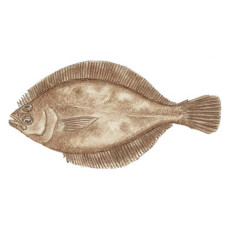Latin name
Citharichthys sordidus
Other names
Mottled sanddab, sole, sanddab, soft flounder, megrim; Spanish: lenguado.
Identification
The body is short, oblong, and compressed. There is a bony ridge above the lower eye. The length of the left pectoral fin is less than the length of the head. The lateral line is almost straight. The scales are cycloidal or weakly ctenoid. The head is deep set, the eyes are large and located on the left side. The coloration is light brown, with yellow and orange speckles on the eye side and white on the blind side. The Pacific sanddab can be distinguished from the long-finned sanddab by the length of the pectoral fin on the eye side. It is always shorter than the head of the Pacific sanddab and longer than the head of the longfin. Sanddabs are always left-eyed, and can be distinguished from other left-eyed flounders by their lateral lines, which are almost straight along their entire length.
Distribution
Occurs in the eastern Pacific Ocean from the Sea of Japan, Aleutian Islands and Bering Sea to Cabo San Lucas, Baja California, Mexico. They are common in shallow coastal waters from British Columbia to California.
Habitat
Sea bottom fish, inhabits waters of the shelf and slope at depths from 9.1 to 549 m, more often at depths up to 90 m. Dwells on sandy substrates. Most abundant at depths of 120 to 300 feet.
Size
Length up to 41 cm. In the California area, the average body length in the first year of life is about 9.5 cm, 14.8 cm in the second, 19.2 in the third, and 22.6 cm in the fourth. From this age, females outpace the growth rate of males, with females averaging 27.4 cm in length and males 24.6 cm by the end of the seventh year. Puberty occurs at a length of 17-22.5 cm, 50% of specimens mature at a length of 19 cm at the age of 3-4 years. These fish can reach 16 inches and 2 pounds, but are usually only 10 inches or smaller than half a pound.
Life history and Behavior
Females are larger than males and usually become sexually mature at age 3 at about 8 inches in length. They produce many eggs, and each fish probably spawns more than once per season. The spawning season peaks in July-September.
Food and feeding habits
The food includes: small fish, squid, octopus, shrimp, crabs, worms and other objects.
Reproduction
Spawning occurs at depths of 10 to 100 m. In the Puget Sound area, it is recorded in February. In the California area, there are 2 peaks in the number of its larvae in January-February and in August-October. Eggs are pelagic with a smooth shell, 0.78-0.84 mm in diameter, with one fat drop 0.08-0.11 mm in diameter, and the yolk is homogeneous. The prelarvae are less than 2.6 mm in length at hatching. Metamorphosis occurs at body length of about 20-25 to 40 mm.
| Classification | |
| Phylum | Chordata |
| Class | Actinopterygii |
| Squad | Pleuronectiformes |
| Family | Paralichthyidae |
| Genus | Citharichthys |
| Species | C. sordidus |
| Features | |
| Conservation status | Least Concern |
| Habitat | Bottom |
| Life span, years | 7 |
| Maximum body weight, kg | No information |
| Maximum length, cm | 41 |
| Sailing speed, m/s | No information |
| Threat to people | Edible |
| Way of eating | Predator |


